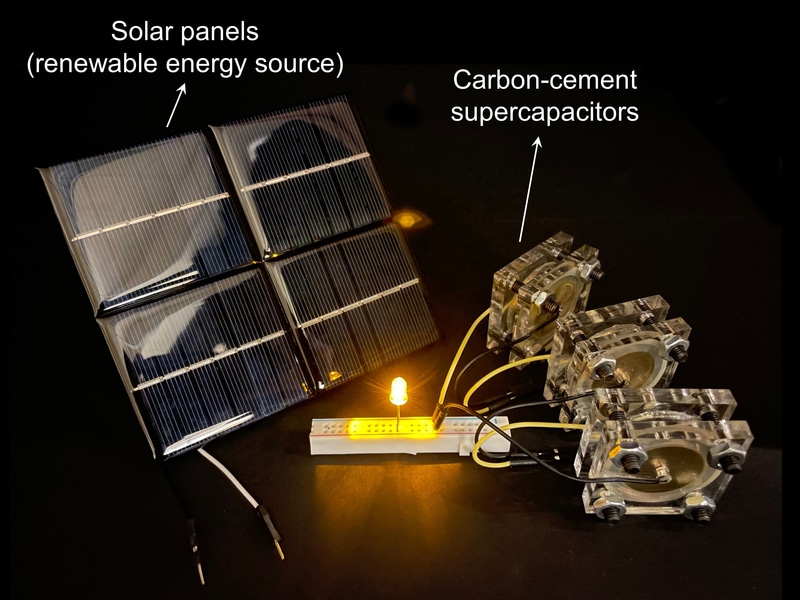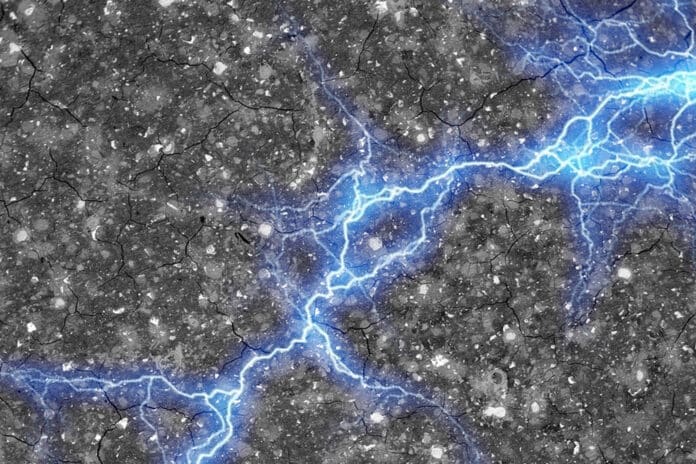Cement and carbon black are two of humanity’s most ubiquitous historical materials. A new study suggests they can be used to create novel, low-cost energy storage systems.
MIT engineers have created a supercapacitor using these materials. They combine these two materials with water and let it cure. By enabling energy networks to stay stable despite fluctuations in renewable energy supply, the technology may make deploying renewable energy sources easier, including solar, wind, and tidal power.
As scientists reported, the newly developed supercapacitor could eventually be incorporated into the concrete foundation of a house, where it could store a full day’s worth of energy while adding little (or no) to the cost of the foundation and still providing the needed structural strength.
The key to this team’s new supercapacitors is a technique for creating cement-based materials with an incredibly large internal surface area because of a dense, linked network of conductive material within their bulk volume. The highly conductive carbon black the scientists added to a concrete mix of cement powder, water, and other ingredients helped them achieve this.
As water reacts with cement to naturally create a branching network of apertures inside the structure, carbon migrates into these openings to create wire-like structures within the cured cement. These structures feature a fractal-like structure, with bigger branches sprouting smaller branches, sprouting even tiny branchlets, and so on. This process results in an enormously high surface area within a very small volume.

Scientists then soaked the material in a standard electrolyte material, such as potassium chloride, which provides the charged particles that accumulate on the carbon structures. Two electrodes of this material create a very potent supercapacitor joined together by a narrow gap or insulating layer.
The capacitor’s two plates work exactly like the two poles of an equivalent-voltage rechargeable battery: when it is linked to an electrical source, like a battery, energy is stored in the plates, and when it is connected to a load, electrical current flows back out to supply power.
MIT professor Admir Masic said, “The material is fascinating because you have the most-used manmade material in the world, cement, combined with carbon black, a well-known historical material — the Dead Sea Scrolls were written with it. You have these at least two-millennia-old materials that when you combine them in a specific manner, you come up with a conductive nanocomposite, and that’s when things get interesting.”
“As the mixture sets and cures, the water is systematically consumed through cement hydration reactions, and this hydration fundamentally affects carbon nanoparticles because they are hydrophobic (water repelling).”
“As the mixture evolves, the carbon black is self-assembling into a connected conductive wire.”
This process is easy to reproduce with inexpensive materials and readily available anywhere in the world.
Masic said, “The process is easily reproducible, with materials that are inexpensive and readily available anywhere in the world. And the amount of carbon needed is very small — as little as 3 percent by volume of the mix — to achieve a percolated carbon network.”
According to the team’s calculations, a block of concrete with nanocarbon-black doping that is 45 cubic meters (or yards) in size, or roughly the size of a cube that is 3.5 meters across, would have enough capacity to store about 10 kilowatt-hours of energy, which is regarded as the typical daily electricity usage for a household.
A house with a foundation composed of this material might store a day’s energy generated by solar or wind turbines and allow it to be used whenever necessary because the concrete would retain its strength. Additionally, supercapacitors have a significantly faster charging and discharging rate than batteries.
After a series of tests used to determine the most effective ratios of cement, carbon black, and water, the team demonstrated the process by making small supercapacitors, about the size of some button-cell batteries, about 1 centimeter across and 1 millimeter thick, that could each be charged to 1 volt, comparable to a 1-volt battery.
They then linked three of these to show they could power a 3-volt light-emitting diode (LED) with this arrangement. After demonstrating the concept, they now intend to construct several larger models, starting with ones roughly the size of a common 12-volt vehicle battery and progressing to a 45-cubic-meter model to show its capacity to store enough energy to power an entire house.
They discovered a trade-off between the material’s structural strength and storage capacity. Although the concrete is a little bit weaker due to adding additional carbon black, this could be advantageous in applications where the entire strength potential of concrete is not required or where the concrete is not playing a structural role. They discovered that the “sweet spot” for applications like foundations or the structural components of a wind turbine’s base is around 10% carbon black in the mixture.
This new supercapacitor could be used for building concrete roadways that could store energy produced by solar panels alongside the road and then deliver that energy to electric vehicles traveling along the road using the same kind of technology used for wirelessly rechargeable phones.
MIT professor Franz-Josef Ulm said, “The system is very scalable, as the energy-storage capacity is a direct function of the volume of the electrodes. You can go from 1-millimeter-thick electrodes to 1-meter-thick electrodes, and by doing so, basically, you can scale the energy storage capacity from lighting an LED for a few seconds, to powering a whole house.”
Journal Reference:
- Nicolas Chanut, Damian Stefaniuk, James Weaver, and Franz-Josef Ulm. Carbon–cement supercapacitors as a scalable bulk energy storage solution. PNAS. DOI: 10.1073/pnas.2304318120
